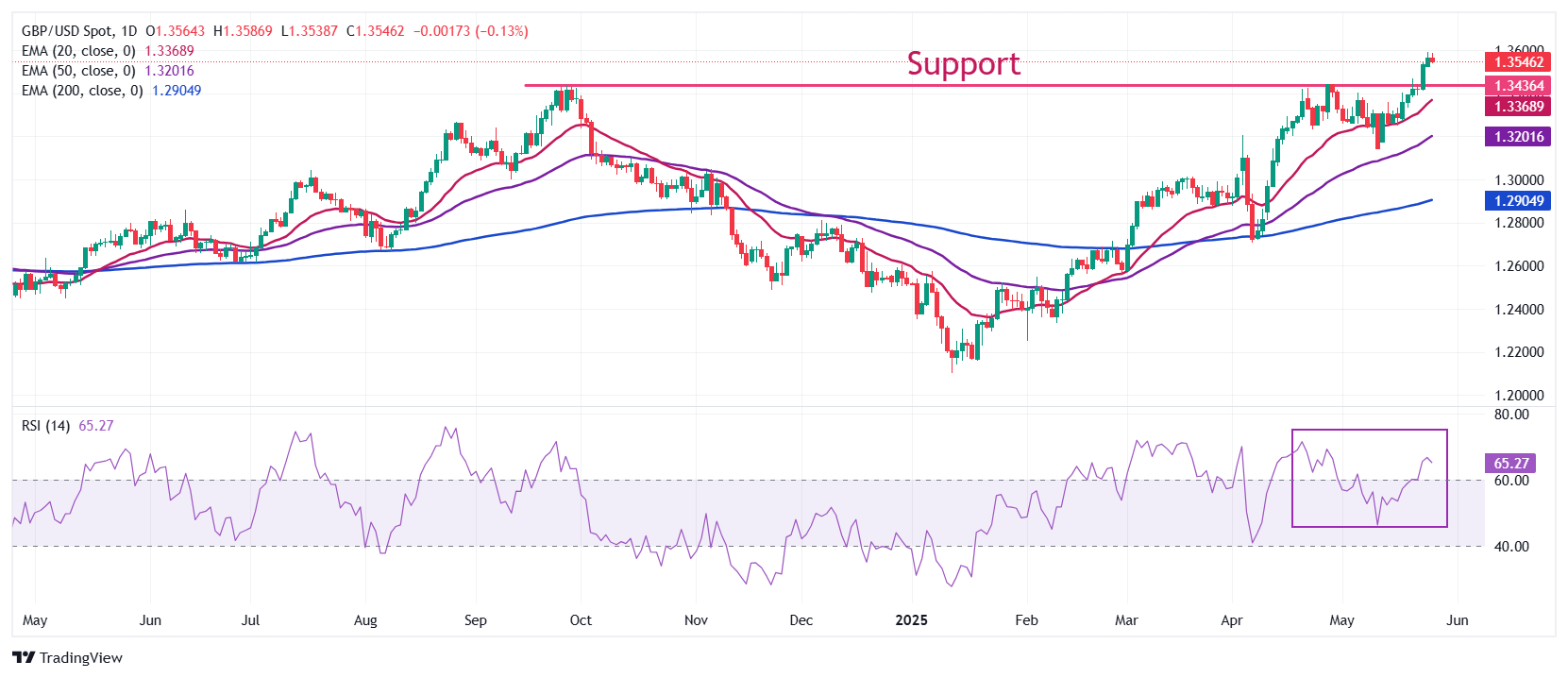-
The Pound Sterling retreats to 1.3550 against the US Dollar amid lingering uncertainty over the US economic outlook.
-
Fed’s Kashkari cautions about stagflation risks under President Trump’s administration.
-
Traders scale back dovish expectations for the BoE following a series of strong UK economic data.
The Pound Sterling (GBP) pulled back to around 1.3550 against the US Dollar (USD) during Tuesday’s European session, retreating from the three-year high near 1.3600 reached the previous day. The GBP/USD pair weakened as the US Dollar rebounded, although the Dollar’s outlook remains fragile amid investor uncertainty over how upcoming bilateral trade deals will impact the US economy.
At the time of writing, the US Dollar Index (DXY), which measures the Greenback’s value against six major currencies, climbed to nearly 99.35 after bouncing from a monthly low of 98.70.
Federal Reserve officials have expressed concerns that President Donald Trump’s new economic policies could trigger stagflation risks. They caution that monetary policy adjustments should be withheld until the extent of inflation increases and economic growth slowdown become clearer.
Speaking during European trading hours, Minneapolis Fed President Neel Kashkari emphasized the need for patience: “Until there is more clarity on the path for tariffs, their impact on prices and economic activity, I will support holding interest rates steady.” He highlighted the elevated uncertainty caused by tariff fallout, noting, “Uncertainty is something that is top of the mind for the Fed and US businesses as we try to navigate inflation and the labor market.” Kashkari also acknowledged, “There’s no question that the shock of tariffs is stagflationary.”
Further pressure on the US Dollar comes from ongoing uncertainty surrounding Washington’s trade talks with Japan, China, and the European Union (EU). Over the weekend, President Trump extended the deadline for the 50% tariffs on the EU from June 1 to July 9, following assurances from European Commission President Ursula von der Leyen that the EU will accelerate trade negotiations and requested additional time to reach a favorable agreement.
On the economic calendar, investors are awaiting the US Durable Goods Orders report for April, scheduled for release at 12:30 GMT. Durable goods orders are expected to have fallen by 7.9%, following a strong 9.2% increase in March.
Daily Market Movers: Pound Sterling Gains Against Most Major Currencies
- The Pound Sterling showed strength against most of its major peers on Tuesday, except the US Dollar, as traders grew more confident that the Bank of England (BoE) will pursue a more moderate monetary easing cycle than initially indicated in its recent policy announcement.
- According to Reuters, futures markets suggest traders expect borrowing costs to fall by around 38 basis points (bps) by year-end, implying a 25 bps interest rate cut and roughly a 50% chance of a second cut.
- This growing confidence is supported by robust UK economic data, including stronger-than-expected first-quarter GDP growth, a hotter-than-forecast Consumer Price Index (CPI), and solid Retail Sales figures for April. The Office for National Statistics (ONS) reported the UK economy expanded by 0.7% in Q1, CPI accelerated to 3.5% year-over-year, and Retail Sales rose 1.2% month-over-month.
- Earlier this month, the BoE cut borrowing rates by 25 bps to 4.25% with a 7-2 vote, signaling a “gradual and careful” approach to further rate reductions. BoE Chief Economist Huw Pill, one of the two dissenters who preferred to hold rates steady, expressed confidence in the ongoing disinflation trend during a speech at Barclays in London. Pill argued that the pace of quarterly 25 bps cuts since last summer has been too rapid given the inflation outlook and stressed the need for caution due to the balance of risks to price stability.
Technical Analysis: Pound Sterling Holds Above Key EMAs Amid Bullish Momentum

The Pound Sterling retraced to 1.3550 against the US Dollar on Tuesday after reaching a fresh three-year high the day before. The near-term trend for GBP/USD remains bullish, supported by all short- to long-term Exponential Moving Averages (EMAs) trending upward.
The 14-day Relative Strength Index (RSI) climbed close to 70, signaling strong bullish momentum.
On the upside, the key resistance to watch is the January 13, 2022, high at 1.3750. To the downside, the April 28 high at 1.3445 serves as a significant support level.





